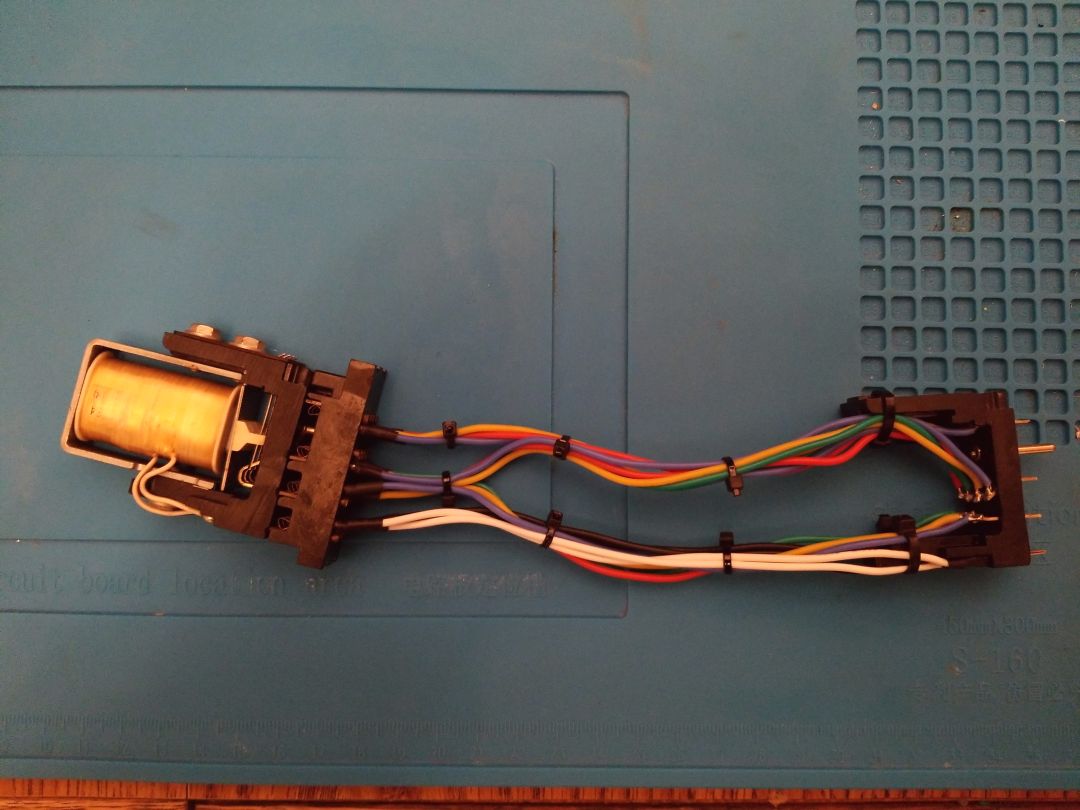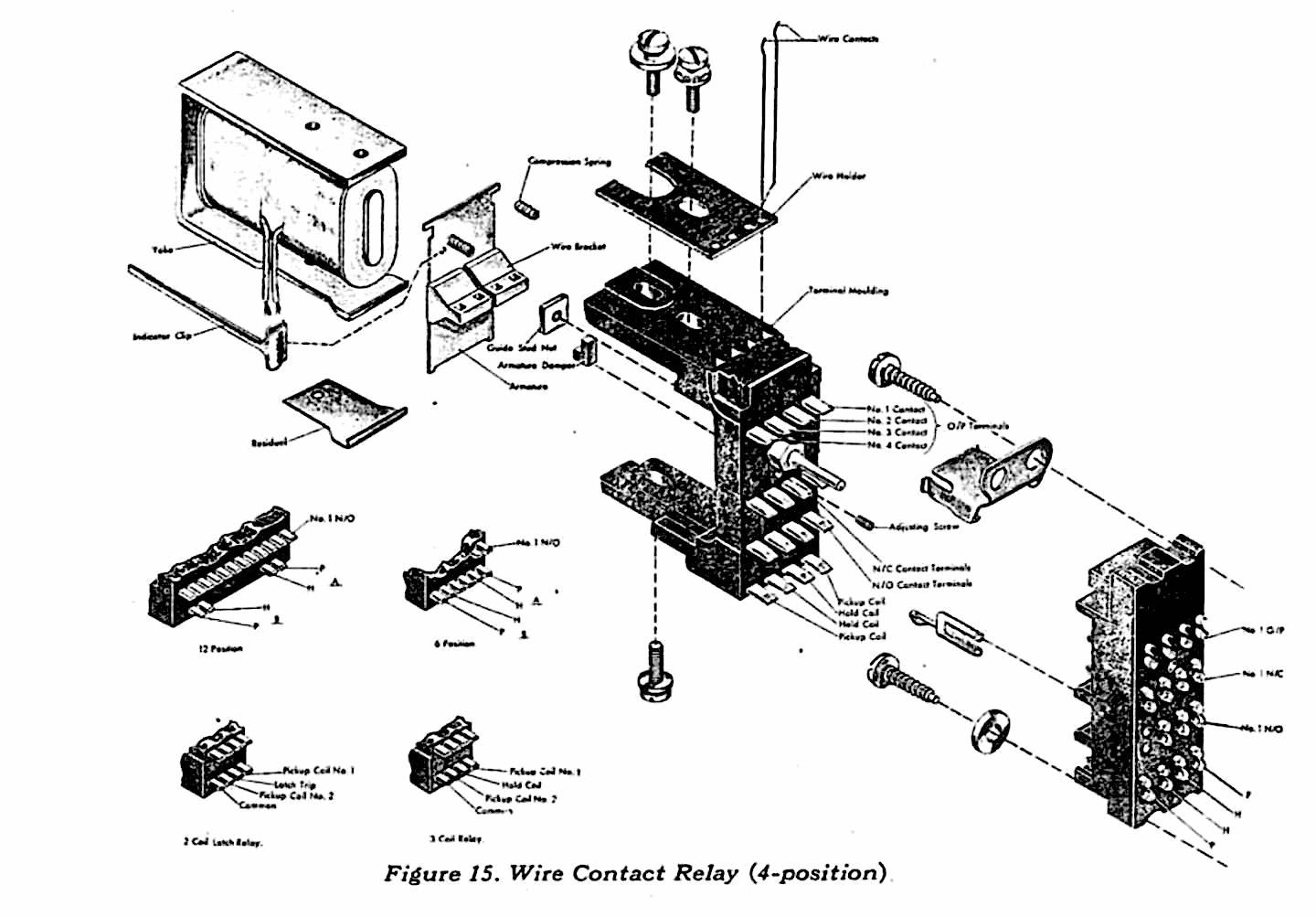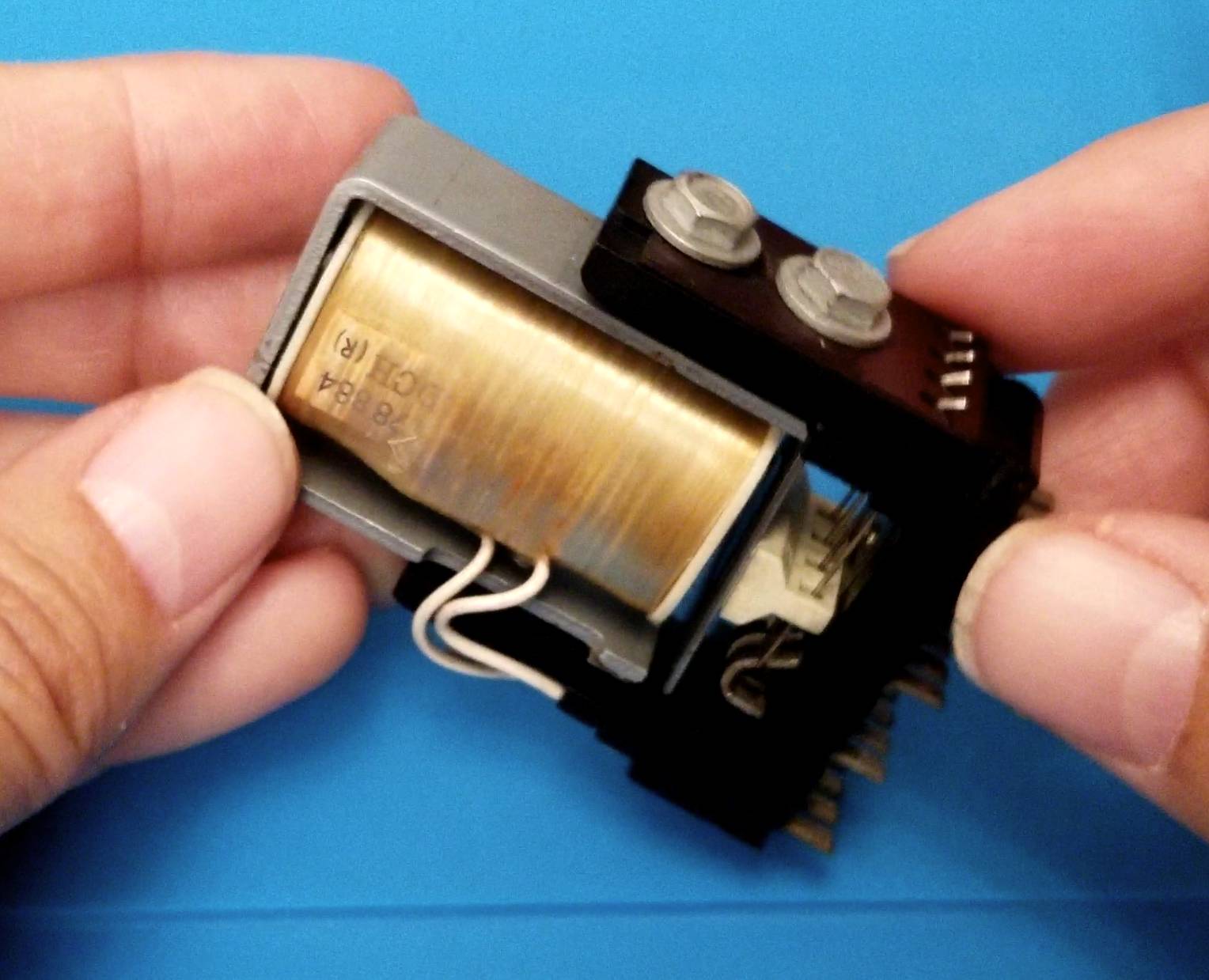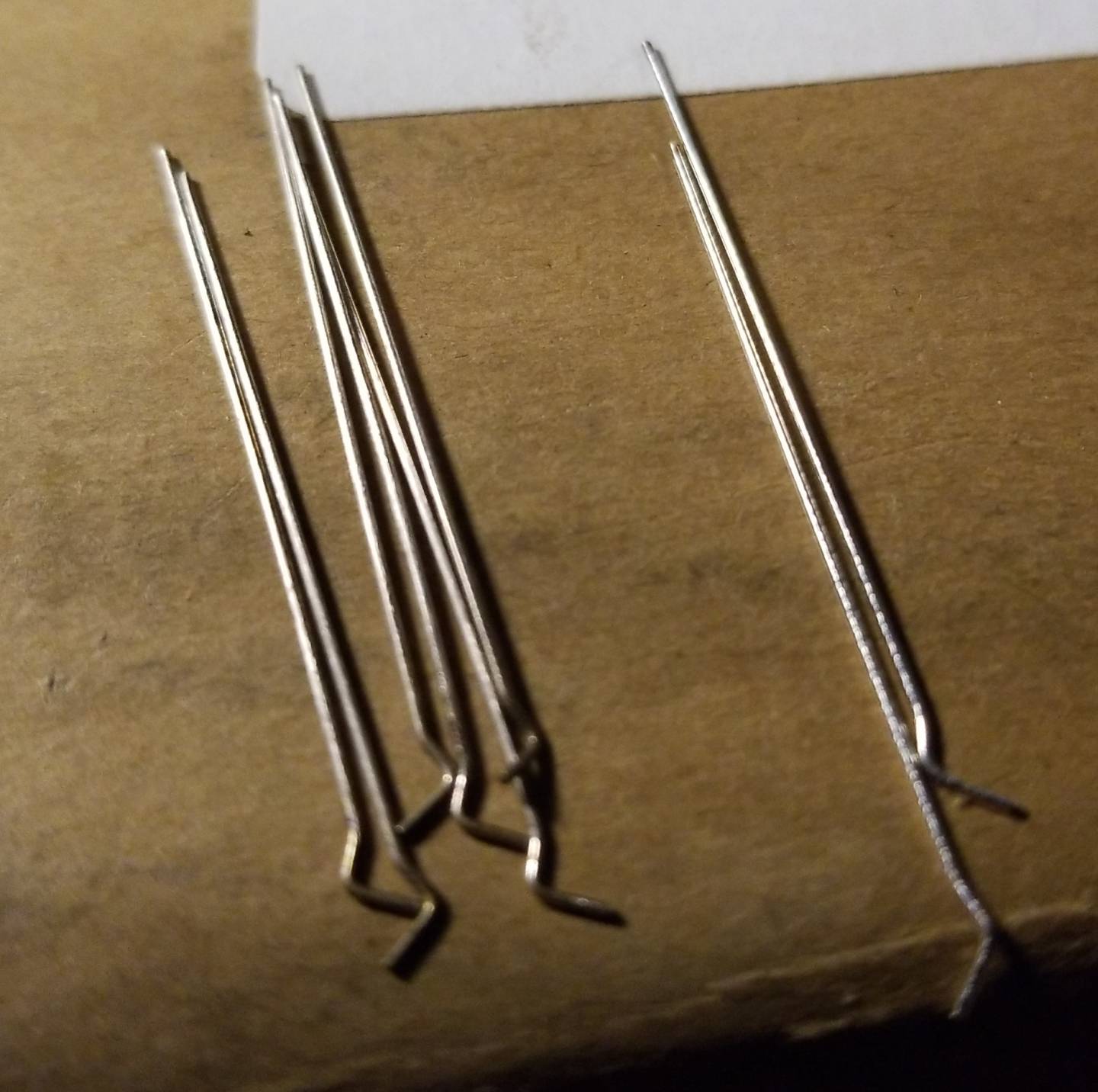Return to Continuing Maintenance
Maintenance of Wire Contact Relays
started Dec 2022
Table of Contents
- What is a Wire Contact Relay
- Current Restoration Efforts
- New Relay Extender
- A quick sequence of wire relay maintenance comments.
- Video on scope of -defective- wire relay
What is a Wire Contact Relay - from Brenda Make
|
Wire Relay-Overall
The wire-relays are fairly fast actuating relays, apparently developed made for 1940s and for logic use. The movable contact in them is silver or gold plated wire. The wire end is bent for grasping and alignment. Two wires are used for each relay contact, double non-wipe contacts. There are non-latching as well as latching varieties. The latching-type relays have a cylindrical coil on the top their metal bracket. A rounded guide pin is moulded into the bottom of each relay. This pin is actually hollow, likely plated-brass, which work-hardens. The pin can be bent or broken on relay insertion or extraction.
Wire Relay Coils
The non-latching ones often have 2 coils, one for Pick (up) and one for Hold. The outer coils are Pick; the center for Hold. Generally, the leads for the coils are marked for polarity--not for winding pairs.
The wires suggest the coil resistance, which I have seen either ~600 Ohms, or ~1,500 Ohms. Oddly, many of the relays have the same Pick and Hold coil DC resistance. The latching ones I have see use the Hold contacts for the latching coil.
Relay Wire Contacts
All the contact wires I have seen are silvered wires ones. While the silver-plating tarnish is conductive, some wires have tarnish and corrosion that can felt with a fingernail. Some wires have varying amounts of tarnish removed by the moulded-on contacts. Some wires have shiny wear marks perpendicular to the length wire, suggesting that the silver may be worn through.
Moulded-in Contacts
The contacts that are moulded into the relay base appear to be silver-plated also--including the socket contacts. Cleaning the contacts non-abrasively would likely require: disassembling the relay, and either checking with a feeler gauge, or adjusting a over-travel adjustment screw threaded into the bottom of the relay, upon assembly, not to mention desoldering/resoldering the coils. Two tiny springs are in each relay, which are about 3/32" in diameter.
Preliminary Restoration Notes:
Generally, I am testing relays with more-often working normally-closed contacts, but failing normally-open contacts. This is consistent with tarnish caused by the sulfur in our air, as well as likely corrosion caused by the same moisture that caused the blade-contacts, screws, and the back chrome trim to rust in the German 729 tape drive. My theory is also that when we destructively examine a wire-relay, we will see steel corrosion where the silver has worn on the contacts, as well.
|
Current Restoration Efforts - from Brenda Make
Current Restoration Effort
Fortunately, we have a decent, but exhaustible supply of replacement wires. (Each relay takes at least 8 wires.). I feel that the conduction of the wires warrants replacement. The replacement wires are identifiable by fine tooling marks on their side. Otherwise, they appear to be a direct replacement. A few relays wires have been replaced, already. These were quite lightly cleaned with #2000 paper.
"The weight of a cigarette paper."
--David, from Prometheus
We have one IBM relay burnishing tool that I feel fine enough (#1000-#2000) to clean the moulded-in contacts. This tool is so fine you can barely feel the grit on it, if it is grit; it may also be sandblasted hard-plated steel. Also, this tool remains flat(er) as not to favor the outside contacts. For that reason, gentle and level pressure is best. IBM's stated tolerance on the non-adjustable contact gap is .001" or the thinness of a cellophane wrapper. Even with the IBM burnisher: very light pressure, very square to the contacts, try to get the center ones. Manta: please get it done within 5 short movements.
(I feel that we also have an assortment of files and coarse sandpaper that should never be brought anywhere a relay.)
[A safer process to clean the contacts: to suspend the relay, immersing the contacts in an ultrasonic cleaner. This would negate the disassembly/reassembly issues involving the coils. A small amount of Kool-Mist type mist/flood coolant solution could be added to the distilled water and cleaning solution to prevent rusting of the steel. The distilled water over mineral-rich water would help reduce rust, slightly, as reported by flood-coolant machinists.]
I have placed the old contacts in a bag, so they may be batch cleaned, at some point. If we obtain chemical silver cleaner, it's probably best not have the container open longer than we have to. It's amazing that it can cause goiters!
I have been cleaning the the tarnish from the relay (blade) pins using folded #2000 paper. The aim isn't to make the blade spotless, getting at least 50% of the surface shiny.
Also, cleaning the Common contacts are not easy. Fortunately, that has not been a prevalent problem. I used Deoxit on a swab, with very firm pressure, with the aim that the fluff on the swab will clean the inside the contact wire hole--and not just the surface.
Before placing the wires in the relay, the relay is cleaned with canned-air to remove particles, and then contacts are sprayed with Isopropyl alcohol.
(I would worry that the working contacts, if sprayed with contact cleaner that contains oil, that the oil would carbonize, while Picking (making) and breaking.
Using a swab, Dexit, this time with oil is wiped on the relay socket contacts (only), so lessen the relay insertion/extraction force.
What didn't work well:
Cleaning the moulded in contacts with unsupported sandpaper.
Perhaps reusing the wires we have.
Take Care,
Brenda
|
A quick sequence of wire relay maintenance comments.
Wire Relays, cleaning indefinitely??
(Oldest near top, here)
from Tom Szolyga - Link for plating kits & supplies - 12/21/2022 3:39 PM
|
Hi Robert,
Here is the link for brush plating:
URL:
https://caswellplating.com/plug-n-plater-silver-plating-kit.html
The company is CASWELL. They have many metal plating products, both consumer and professional. Perhaps “CHM” could arrange a conf call to explain our application and ask for their recommendations.
Best regards,
Tom
|
from Robert Garner - 12/22/2022 8:18 AM
|
Stan, Marc,
The long-term question I was contemplating yesterday is: Can we indefinitely clean relay wires (with cleaning wipes or ultra-fine 1000-grit sandpaper/sticks)? After repeated cleaning cycles, do silver-plated relay wires become unreliable? Silver has such a bad reputation after all. If so, should we consider experimenting with replating the wires? Naturally, if we can acquire sufficient NOS wires, replating is unnecessary.
Stan —> It’s good to know that we have spare NOS relay wires.
Happy Holidays everyone!
— Robert
p.s. Yesterday, Ken mentioned that he had sorted our spare relays according to whether they passed the relay tester.
The bag marked PASS is much smaller than the bag(s) marked FAIL.
|
from Ken Shirriff - 12/22/2022 10:19 AM
|
> p.s. Yesterday, Ken mentioned that he had sorted our spare relays according to whether they passed the relay tester.
The bag marked PASS is much smaller than the bag(s) marked FAIL.
Small correction: I sorted the relays by type since there were two bins of random relays. For the 729 relay replacement, Brenda tested a bunch with a multimeter and all the ones she tested had bad contacts. These relays all had numbers like 119, 121, 122 on them; these are the numbers written on relays in the 729, so clearly these are relays that failed previously. Stan's tester apparently doesn't support wire relays like the ones in the 729; maybe we should add wire relay support.
Ken
|
from Robert Garner - 12/22/2022 2:25 PM
|
Brenda,
Thanks for your detailed email (below) about the tarnished/corroded relays in our DE 729-1 and the pointer to the video by “CelGenStudios” on "Cleaning IBM's Wire Contact Relays” in an 029:
https://www.youtube.com/watch?v=l8DOfmVad9U
His (arduous, perhaps too harsh?) cleaning procedure: Remove the relay wires, submerge them in Deoxit and “gently” rub each inside folded 1500-grit sandpaper ("non-aggressive abrasive”); rub 1500-grid sandpaper wrapped around a Q-tip together with (oily) Deoxit against the relay contacts; and then spray with MG Chemicals Electrosolve contact cleaner (“non-residue”) to remove the Deoxit residue.
He begins by noting that “CuriousMarc kind of ran into this problem, but that was more with the contacts inside the keypunch mechanism itself. The relays themselves were OK.”
> It also seems that the sliver plating, other than tarnishing, becomes worn by the other metal parts it wears against. (Sorry that I didn't get pics, this time)
> This time, I used the magical IBM contact burnishing tool, which appeared to be in the #1,000-#2,000 range.
> That worked well cleaning for the contacts moulded into the relay.
The wearing of the silver alloy plating and use of the burnishing tool or ultra-fine 1500-grit sandpaper is what motivated my question of a potential longer-term solution (and Tom’s suggestion of perhaps trying electroplating if the plating is being mechanically worn by burnishing, etc..)
|
from Ken Shirriff - 12/22/2022 at 2:50 PM
|
I got some 1000 and 2000 sandpaper at Home Depot and will bring it in next time. The places I looked didn't have silver dip, just generic tarnish remover, so I didn't get any of that.
Ken
|
from David Clementson - 12/22/2022 at 4:25 PM
|
Any jewelry supply place will have acidified thiourea "silver dip" (Jax Instant Silver Cleaner, etc.). Amazon has it, but Otto Frei is cheaper. Use gloves and don't drink it though! And it will cause pitting of the silver if it left on too long, so a quick wipe or two should do.
DC
|
|
from Brenda Make - Relay Extender Circuit - 12/24/2022 7:02 PM
|
Hi,
The Relay-Extender seems to be done.

Appears to have no shorts. All contacts connect. I cleaned it with isopropanol, but it should have a bit of deoxit, and a blast of air to make to make sure there are no solder balls.
To make it less sketchy to use, tapered pins could be used--instead of probing the contact edges.
I added a little heat-shrink here for peace of mind. The nature of the thing means that stuff is exposed.
Wires could be added to a wide connector, I don't have anything to use.
It's silicone wire, so it's way bendy.
Take are,
Brenda
Brenda mentioned elsewhere
Cleaning IBM's Wire Contact Relays - https://www.youtube.com/watch?v=l8DOfmVad9U
|
12/24/2022 8:34 PM - Ken says "It looks awesome!"
Video on scope of -defective- wire relay
From Robert Garner, January 19, 2023
Here’s an I-V trace of a defective IBM silver-wire relay (that Stan lent me on Weds).
A miserable and chaotic mess!!
WireRelay_RG_Jan2023.mp4, 6.1 MB, 13 seconds
The trace is across the relay’s normally closed (deactivated solenoid) pins, so a good trace would be a vertical line at the origin. The other contacts looked fine/OK.
I found a few period articles on the unusual and complex semiconductor or “mixed conductor” properties of silver sulfide, the black tarnish we see on the wires. I’ll share the articles later…
|
Send comments etc. to Ed@Ed-Thelen.org



